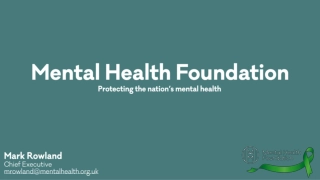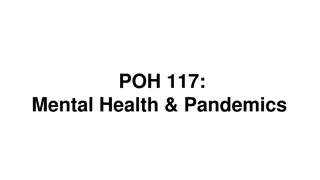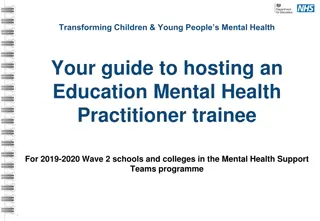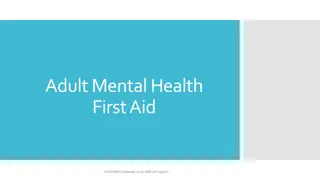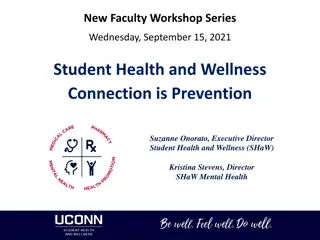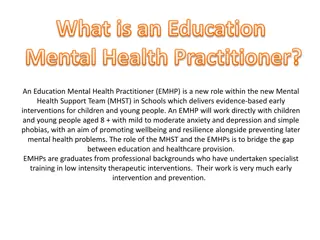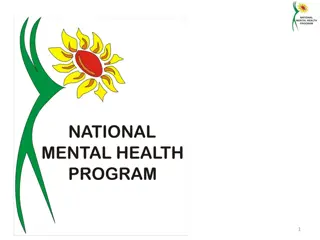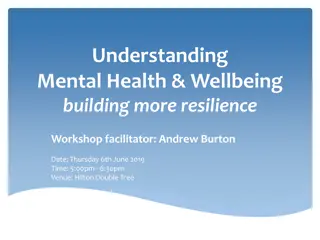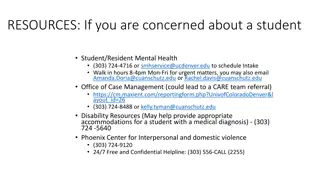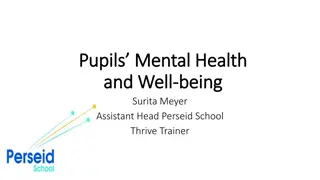Supporting Mental Health in Higher Education: Building a Culture of Acceptance and Resources
In higher education, fostering a culture of acceptance and care towards faculty and staff's mental health is vital. Institutions can support this by reducing stigma, promoting open communication, and embracing diversity. Key actions include raising awareness, training leaders, and addressing concerns promptly. Assess your institution's current culture by evaluating safety in discussing mental health and inclusive practices. Utilize resources from organizations like NAMI and NIMH to initiate conversations and promote mental well-being.
Download Presentation

Please find below an Image/Link to download the presentation.
The content on the website is provided AS IS for your information and personal use only. It may not be sold, licensed, or shared on other websites without obtaining consent from the author.If you encounter any issues during the download, it is possible that the publisher has removed the file from their server.
You are allowed to download the files provided on this website for personal or commercial use, subject to the condition that they are used lawfully. All files are the property of their respective owners.
The content on the website is provided AS IS for your information and personal use only. It may not be sold, licensed, or shared on other websites without obtaining consent from the author.
E N D
Presentation Transcript
A Framework A Framework for Supporting for Supporting the Mental Health the Mental Health of Faculty and Staff of Faculty and Staff in Higher Education in Higher Education Culture Flexibility Resources
Culture Culture Building a culture of acceptance, acknowledgement and care is important as we incorporate a commitment to employee mental health and well- being into the campus culture. Institutions can support this ideal culture by first working to decrease the stigma often attached to topics of mental health. Seeing other employees, especially supervisors and top management, embracing positive and open communication creates a sense of safety and allows more space for these important conversations.
Key Actions Key Actions Carry Through Communicate Raise awareness, build trust and encourage open communication by: Demonstrate your institution s commitment to supporting mental health by: Holding people accountable Ensuring leaders are properly trained Addressing employee feedback and concerns promptly Making accommodations when possible or necessary Recognizing and celebrating diversity Educating your campus on correct terminology Including and addressing all stakeholder groups Culture
Assess Your Institutions Current Culture by Asking: Assess Your Institution s Current Culture by Asking: Do employees feel safe and welcome to discuss their mental health concerns openly? Are we using supportive language when discussing mental health? Do our diversity statements, policies and other DEI resources include individuals with mental illnesses? Do our supervisors and managers have the training they need to; recognize distress, start a conversation, and direct employees to our institution s resources? Where and how do we communicate the resources we have available (ex: posters, web pages, e-mails, on-campus offices)? Are these communications reaching all of our employees? Culture
Get Started With These Resources Get Started With These Resources National Alliance on Mental Illness s poster and flyer from their Stigma Free Company initiative The Center for Workplace Mental Health s ICU ( I See You ) awareness campaign Education and awareness resources from the National Institute of Mental Health (and suggestions for use) Conversation tips and inclusive language guidance from Make It Ok Interactive online learning experiences from Make It Ok Culture
Resources Resources Offering robust and innovative support for mental health means nothing if a lack of awareness and complex processes are preventing employees from seeking the care they need. Institutions can lessen or eliminate these barriers by increasing resource visibility and ensuring that steps to access care are as streamlined and clear as possible.
Key Components Key Components Awareness Accessibility Make sure all employees are aware of available resources and how to access them by: Ensure that employees are both able and likely to use the resources available to them by: Anticipating and addressing barriers to access Supporting a range of concerns Offering traditional and non-traditional resources Streamlining processes whenever possible Using multiple methods to communicate Keeping communication consistent, clear and concise Considering multiple audiences Resources
Assess Your Institutions Current Resources Assess Your Institution s Current Resources What restrictions do we have to keep in mind when considering our resources? (ex: budget) Are there tools, practices or other resources we can add or adapt for our campus? Are our resources easy to access? Think about: The hours of operation for a service How many steps a specific process takes (ex: connecting with a counselor) Time elapsed between the initial inquiry and any follow up or resolution Any requirements needed to access the resource (ex: a smartphone or tablet) Is information available via multiple avenues (ex: in person, online, over the phone)? Is information readily available to all campus populations? Consider those who might Not have reliable internet or email access Not speak or read English as their primary language Not feel comfortable approaching resources publicly Resources
Get Started With These Resources Get Started With These Resources The Center for Workplace Mental Health s recommendations for improving mental health care access Ideas for benefits that matter from Mental Health America Customizable presentation templates, posters, and handouts from Right Direction Mental Health America s outreach toolkit (includes posters, templates, graphics and more) Resources
Flexibility Flexibility Flexibility takes many forms, and higher education needs to embrace this as a way of acknowledging its commitment to employees who are balancing life and work challenges. The many benefits that come with flexible work, especially as relates to burnout prevention, employee engagement and employee mental health, makes it worth examining to find grace and space within the higher education workplace.
Key Actions Key Actions Encourage Evaluate Create space for flexibility by reviewing and updating policies and practices such as: Show open support for work-life balance by encouraging employees to: Create space and support for flexibility PTO, sick time and leave policies Measures of success Set schedules Take breaks throughout the workday Connect with co-workers Unplug at the end of the day Flexibility
Assess Opportunities for Additional Flexibility by Asking: Assess Opportunities for Additional Flexibility by Asking: Who needs to be in the office or on campus? How often? Why? What scheduling changes (if any) did our institution make during the pandemic? What time can employees use if they Are going on vacation? Must deal with a non-health emergency? Are feeling physically unwell? Are feeling mentally unwell? Have a medical appointment? Must be with a child or spouse? Must be with a parent or grandparent? Must be with another family member or a friend? Flexibility
Get Started With These Resources Get Started With These Resources Basic strategies that support flexible work practices from Mental Health America Indeed s overview of different types of workplace flexibility, and tips for implementation How PwC created a culture of flexibility, from LinkedIn CUPA-HR s Flexible Work Toolkit Flexibility
Additional Resources Additional Resources Flexible Work Toolkit (CUPA-HR) Culture Mental Health Toolkit (CUPA-HR) 5 Things Employers Need to Know from the Mind the Workplace 2021 Report (MHA) 8 Employers Supporting Employee Mental Health During COVID-19 (MHA) Mental Health in the Workplace: 5 Employee Benefits All Companies Need to Offer (Wellington Steele & Associates) Flexibility Resources



